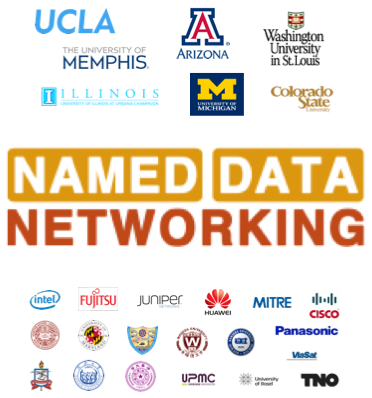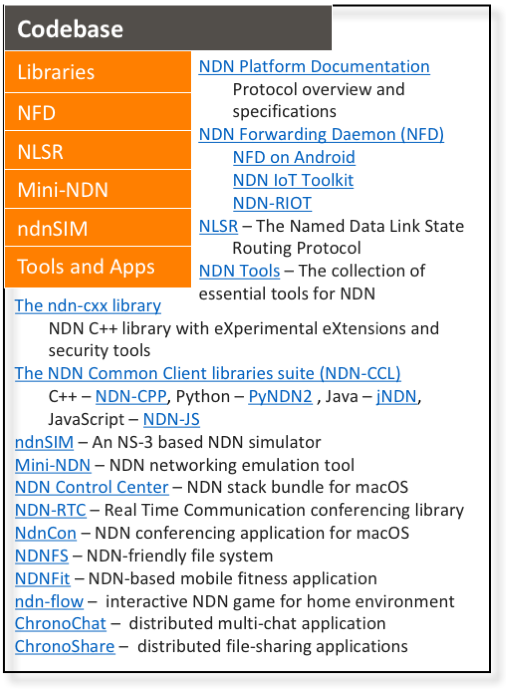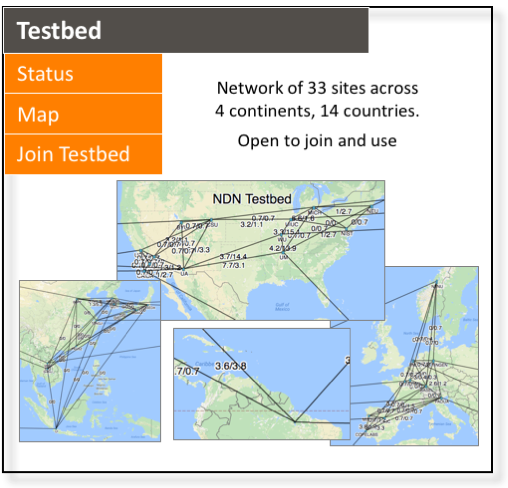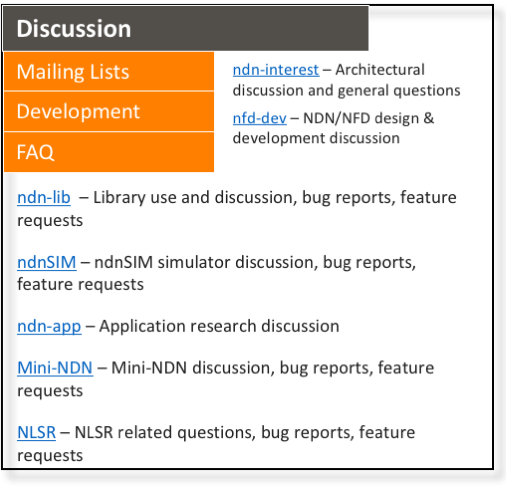This half-day SIGCOMM tutorial provides an introduction to Named Data Networking (NDN), a newly developed data-centric Internet architecture. NDN makes a conceptually simple yet fundamental change to the narrow waist of the Internet’s narrow waist architecture by replaces TCP/IP’s narrow focus on “where” to send packet with “what” content to fetch. We believe that this shift to data-centric networking can greatly help enhance Internet security, enable mobility support, scale both data disseminations as well as data collection (e.g., from IoT devices), as well as facilitate new application developments.

Motivation
Launched in 2010 under the NSF’s Future Internet Architecture program, the NDN project has attracted researchers from both academia and industry around the world to explore all aspects of its design, implementation, and applications. Together with an increasing interests in NDN, however, there are also an increasing number of questions about NDN and its future development, as well as some misconceptions.
This tutorial aims to bring NDN to the broader networking community and invite all interested parties to join its exploration. It will explain NDN’s basic architectural concepts, describe the recent research results, and highlight many of the remaining research topics.
For people who are interested in exploring NDN beyond the above, we have also prepared another half-day activities to supplement the tutorial including (1) demonstrations of NDN testbed operations and a set of NDN applications; (2) introductions to NDN’s open-source code development, the existing codebase and showcases of how to develop NDN applications, illustrating what kinds of new thinking are needed here; (3) NDN experimental tools including the use of NDN testbed, an NDN emulator, mini-NDN, and an NDN simulator, ndnSIM, which has been used in 300+ technical publications; and (4) discussions on how to taking NDN to its next stage.
We expect this tutorial and its supplemental activities to benefit network researchers and students with different levels of background knowledge on NDN/ICN, from people who want to learn what NDN really is, to people who are looking for new topics to explore, and ways to contribute to NDN design and development.
Tutorial Program
Tutorial location: Shannon Room (Engineering IV)

9:00am – 9:05am Welcome and Introduction
9:05am – 10:30am NDN Architecture (Van Jacobson)
Introduction of NDN
10:30am – 10:45am Coffee Break
10:45am – 12:30pm NDN Research (Beichuan Zhang)
Survey on existing NDN research work, with emphasis on research challenges and recent results. The topics include routing, forwarding, caching, mobility, security, and applications. We will wrap up the tutorial by inviting the broader community to join the effort of developing NDN architecture.
Supplemental Afternoon Activities
The following activities are prepared for people who may be interested in exploring more about the NDN’s design and development progresses over the last 7-year period, as well as its current status and remaining research challenges. They are provided free-of-charge to everyone who is interested in learning more about NDN.
1:30pm – 2:30pm NDN Codebase and Development (Alex Afanasyev)
Walk through existing NDN codebase, including the prototype of NDN forwarder, related libraries, simulator and emulator. A short recorded video will be included to show a couple simple coding examples.
2:30pm - 3:15pm NDN Demonstrations I: NDN Scaling (John DeHart)
A number of NDN applications will be demonstrated, some run on the global NDN testbed, and some utilize local connectivity only.
3:15pm - 3:30pm Break
3:30pm - 4:15pm NDN Demonstrations II: Cloud-optional Home IoT (Jeff Burke, Yanbiao Li)
Demonstration of some of the NDN features that allow significant transformation of how Internet-of-Things applications and security in IoT application is realized.
3:30pm - 4:15pm NDN Demonstrations III: NDNHealth (Jeff Burke, Haitao Zhang)
Wrap Up and Q&A
Biographies of Tutorial Speakers
Van Jacobson has been a long-term contributor to the Internet. His algorithms for the Transmission Control Protocol (TCP) saved Internet from congestion collapse in 1980’s and are used by over 90% of Internet hosts today. He developed the blueprint of Named Data Networking (NDN) 10 years ago and continues to serve as the NDN architect.
Lixia Zhang is Professor in the Computer Science Department of UCLA. She received her Ph.D in computer science from MIT and was a member of the research staff at Xerox PARC before joining UCLA. She is a fellow of ACM and IEEE, the recipient of IEEE Internet Award, and the holder of UCLA Postel Chair in Computer Science. Since 2010 she has been leading the effort on the design and development of the NDN architecture.
Beichuan Zhang is Associate Professor at the Department of Computer Science, the University of Arizona. His research interest is in Internet routing architectures and protocols. He has been working on Named Data Networking, green networking, and inter-domain routing. He received the Applied Networking Research Prize in 2011 by ISOC and IRTF, and best paper awards at IEEE ICDCS in 2005 and IWQoS in 2014. Dr. Zhang received Ph.D. from UCLA and B.S. from Peking University.
Jeff Burke is Assistant Dean for Technology and Innovation at the UCLA School of Theater, Film and Television (TFT), where he has been a faculty member since 2001. His research explores the intersections of the built environment, computer networks, and storytelling. He has produced, managed, programmed, and designed performances, short films, new genre art installations and new facility construction internationally for over fifteen years, incorporating emerging technologies as part of these projects and creative works. Burke co-founded REMAP, a joint center of TFT and the Henry Samueli School of Engineering and Applied Science, which uses a mixture of research, artistic production, and community engagement to investigate the interrelationships among culture, community, and technology. From 2006-2012, Burke was the area lead for participatory sensing at the NSF Center for Embedded Networked Sensing (CENS). He is Co-PI and application team lead for the Named Data Networking research project.
Patrick Crowley is Professor of Computer Science & Engineering at Washington University in St. Louis, where he directs the Applied Research Lab. He is also founder and CTO of Observable Networks, a cloud-native network security company. His research interests are in computer and network systems architecture, with a current focus on information-centric networking, programmable network systems design, and the invention of superior network monitoring and security techniques.
John DeHart is a Senior Research Associate in the Applied Research Laboratory (ARL) in the Department of Computer Science and Engineering at Washington University in St. Louis. He has been with ARL at WU since 1989, where he has been involved in development of prototype network systems and software. His current NDN role is management of the NDN Testbed.
Alexander Afanasyev is Assistant Professor in Florida International University, Miami. He received his Ph.D. degree in computer science from UCLA in 2013. His research focus is on the next-generation Internet architecture as part of the Named Data Networking (NDN) project. His research interests include a variety of topics that are vital for the success of NDN, including scalability of name-based routing, auto-configuration, distributed data synchronization, application and network security. Dr. Afanasyev is also leading the development effort of the overall NDN codebase.
Acknowledgments
This material is based upon work supported by the US National Science Foundation through Future Internet Architecture (FIA), Future Internet Architecture Next Phase (FIA-NP), and CISE Research Infrastructure (CRI) programs. Any opinions, findings, and conclusions or recommendations expressed in this material are those of the author(s) and do not necessarily reflect the views of the National Science Foundation.



